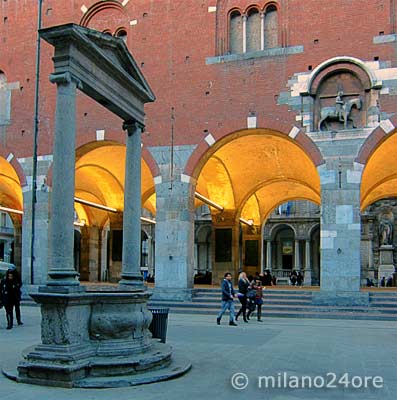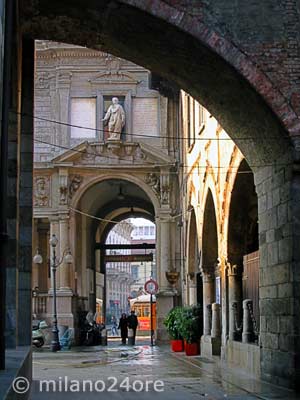milano24ore
Piazza dei Mercanti and the Stone of the Failed
The History of Piazza Mercanti

- Piazza Mercanti with fountain and Palace of Justice
Located in the densely built Milan of the Middle Ages, in the 13th Century there was a central craft and commercial square, Piazza dei Mercanti.
On the rectangular piazza, which at that time was larger than today, hair cutters, goldsmiths, cutlers, cobblers, seamstresses, weavers, tailors and bakers made their's daily jobs.

- Relief with equestrian monument
Oldrado da Tresseno Palazzo della Ragione
1228, work began on the Palace of Justice, which today is located in the center of the Piazza Mercanti.
The relief with the equestrian monument commemorates the Mayor Milan Oldrado because Tresseno who had given the order for the construction.
Palazzo della Ragione
1233 Palazzo della Ragione also called "Broletto", was finished. From now on, the central judicial matters were handled here.
The Palace of Justice consisted, as usual in other cities of Lombardy, in an open ground floor for meetings of the population and one upstairs for meetings of the Council. From the loggia of the decisions were announced.

- Palazzo della Ragione, called „Broletto“
Today the Palazzo delle Ragione is used for exhibitions, etc. offered the high rooms an ideal setting for "Show impossibile with the works of Caravaggio".
Another impressive building in Piazza dei Mercanti is the Loggia degli Osii opposite the Palazzo delle Ragione.
Between the Palazzo della Ragione and Loggia degli Osii is a fountain from the 16th Century, in the 18th Century was fitted with two covered pillars.
Loggia degli Osii

- Palace of the schools of the Palatine
The Loggia degli Osii was built in 1316 by Matteo Visconti, to give the court a notary office. Unusual for the Lombard style, the Gothic facade was designed with alternating black and white marble stiffeners, as it is often found in Genoa.
The balcony, also called Parlera, served for the Annunciation. It is decorated with the emblem of the Visconti and with an eagle with prey as a symbol of justice.
On the upper floor, there is a series of sculptures of the saints of Milan.
Palace of the schools of the Palatine
The schools of the Palatine have ancient roots. The building burned down completely in 1644. The beautiful palace portico was completely rebuilt in 1664 by architect Carlo Buzzi after the model of the adjacent Palace of Giureconsulti.
The entrance is flanked by arcades, reached over six steps.
In the center over the entrance is a statue of Sant'Agostino, who according to tradition is said to have taught at the school.

- Palace of Giureconsulti
The Palace of Giureconsulti
Since 1911, the building has been used by the Milan Chamber of Commerce.
In a niche in the facade of the palace there is a statue of St. Ambrose, a work of Luigi Scorzini 1833.

- Relief from the Roman period depicting a wild boar
Curiosities and Myths
On one of the arches of the "Broletto" is a stone with a relief from the Roman period depicting a wild boar. There is a mythological representation and was the first landmark of the ancient Mediolanum.
According to legend, the Celt Belloveso had founded the city on the spot where he had met the magical animal.
The stone of Failed
During the active trading hours in Piazza Mercanti it happened that a dealer fell into disgrace because he had cheated.
As punishment, he was left to public scorn and set with his pants down on the stone of Failed. He was ridiculed by the common people, before he went to prison.
